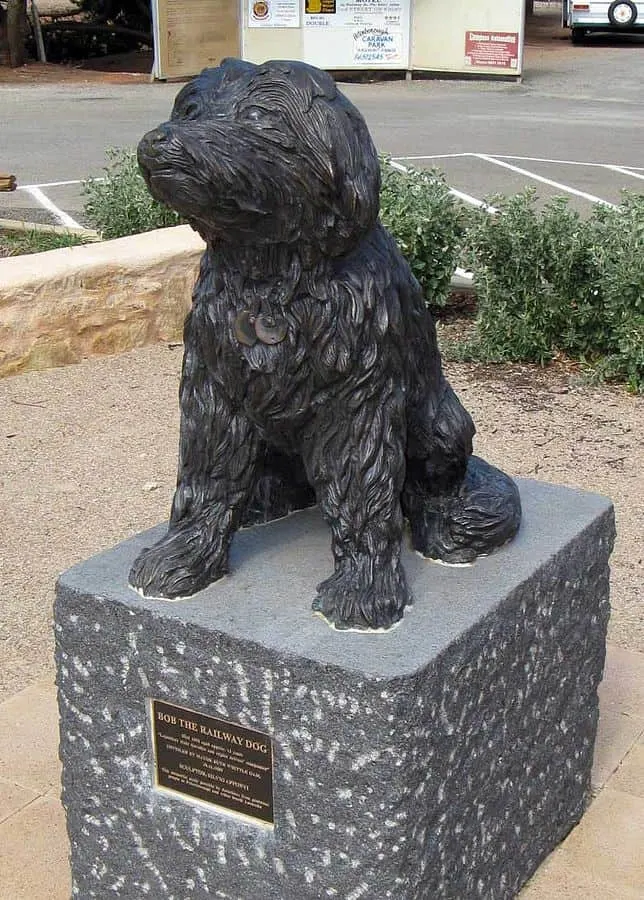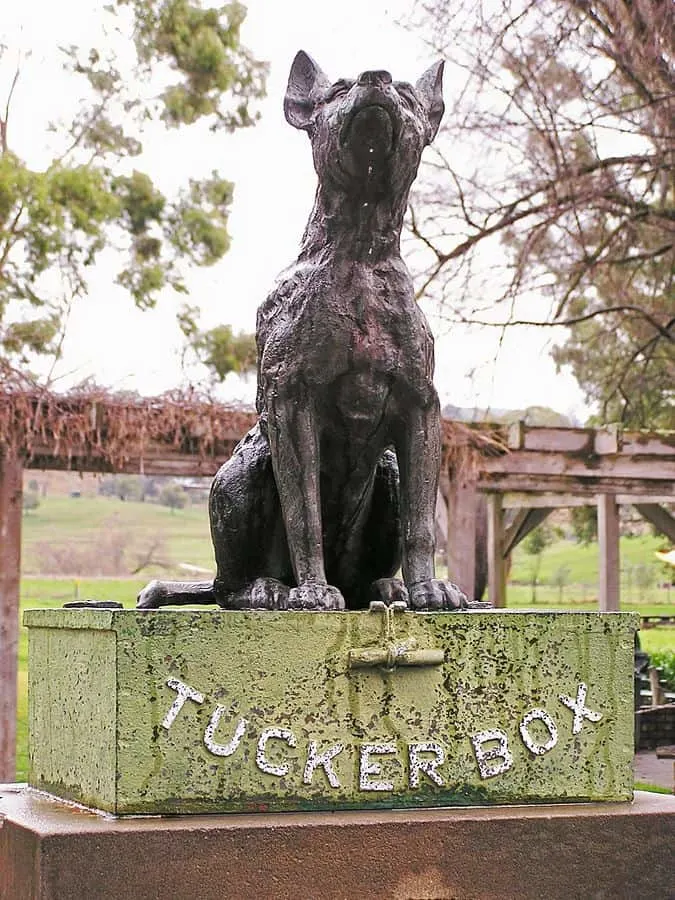Aristotle once wrote that “The aim of art is to represent not the outward appearance of things, but their inward significance.” Over the years Australian artists have unleashed their skills through the medium of sculpture to express the significance of dogs in our lives. In the second installment of DogTipper’s series of articles that shine a light on fine art and our furry friends, we look at a few of the many sculpted depictions of dogs in The Land Down Under.
“Stop me not, but let me jog/For I am Bob, the drivers dog.” A catchy couplet engraved on his collar let everyone know that the German Coolie/Smithfield mix known as Terowie Bob was a tail-wagger with a passion for travel. The cuddly canine, who kept railwaymen company as they chugged along the tracks in the late 1800s, is remembered today by people who pass by Main Street in the Australian city of Peterborough thanks to a statue which was erected in the dog’s honor in 2009. (Fans of Fidos can find out more about this roaming Rover by reading The Railway Dog: The True Story of an Outback Dog by Olwyn M. Parker.)

By Sulzer55 – Own work, CC BY 3.0, https://commons.wikimedia.org/w/index.php?curid=14918717
Dr. Arnold Cook, who lost his sight as a teenager, brought his vision of Australia’s first guide dog training center to Perth in 1951. A leader of the country’s Guide Dog Movement, Cook and his canine companion Dreena have been immortalized in a bronze statue which stands outside the Association of the Blind in Victoria Park.

By Moondyne – Own work, CC BY-SA 3.0, https://commons.wikimedia.org/w/index.php?curid=12888837
The memory of Red Dog, a nomadic Kelpie/cattle dog whose paws promenaded through Western Australia’s Pilbara region in the 1970s, lives on in the mining town of Dampier. A beloved part of the community, in life Red Dog was made a member of the Dampier Salts Sport and Social Club, the Transport Workers’ Union, and was even gifted with his very own bank account at the Bank of New South Wales. After his passing in 1979, the community commissioned sculptor Meri Forrest to create a monument which today greets visitors of Dampier. (Fans of films about Fidos can find out more about the dog dubbed the ‘Pilbara Walker’ by watching the 2011 movie Red Dog.)

By Anthony b Loveridge – Red Dog website – reddogwa.com, CC BY-SA 3.0, https://commons.wikimedia.org/w/index.php?curid=17854821
The statue of a Skye Terrier named Islay, who once won the heart of England’s monarch, wins the admiration of every dog lover who passes by the Queen Victoria Building in Sydney. In a permanent begging pose, the depiction of Queen Victoria’s canine companion speaks to sightseers in a human voice, and thanks all who toss a coin for a children’s charity into the fountain he guards.
Inspired by a popular poem about a loyal canine who diligently watches over his human’s lunchbox, the Dog on the Tuckerbox statue offers visitors a feast for the eyes. A creation of sculptor Frank Rusconi, the stouthearted Spot made its debut in 1932, and can be found standing watching over coins placed in the monument’s wishing well outside of the Dog on the Tuckerbox Tourist Centre in Snake Gully, near Gundagai, New South Wales.

By AYArktos – Own work, CC BY-SA 2.5, https://commons.wikimedia.org/w/index.php?curid=406506
A touching tribute to the strong bond between soldiers and the loyal canines who serve by their side, sculptor Ewen Coates created Elevation of the Senses. The portrayal of an Explosive Detection Dog and handler can be seen at the Australian War Memorial Museum.
Statues of Dogman and Rabbitgirl can be seen around the globe, and sightseers in Paddington, Sydney can spot the unique pair of lovebirds as they enjoy the beauty of the city from their moped! Located at the intersection of Glenmore Road and Cascade Street, the whimsical work It Takes Two was created by the husband and wife team of Gillie and Marc.
In the 1950s tartan-wearing tail-wagger Puppy promenaded through the streets during the annual Carnival of Flowers parade as the mascot of the Toowoomba Thistle Pipe Band. Sadly, the dog lost his life during the 1958 parade when he was struck down by a car. In loving memory of the canine who had brought so much joy to the community, a statue of Puppy— which was erected the year after his passing– today brings a smile to the faces of visitors of Picnic Point, part of a reserve in Rangeville, Queensland.

By Shiftchange – Own work, CC0, https://commons.wikimedia.org/w/index.php?curid=36685714
On December 3, 1854 Wee Jock guarded his human as he lay dying on the battlefield during the Eureka Stockade Rebellion. Today a bronze depiction of the faithful Irish terrier stands as a silent sentinel forever protecting 22 gold posts– one for each of the gold diggers who lost their lives in the skirmish, including the man who cared for the canine now known as The Pikeman’s Dog.
Written in 1904, a segment of a letter offers a poignant portrait both of the battle’s devastation and the personal loss felt by one fallen’s faithful friend, who was determined to stay beside his buddy even when they took his body away. “No human being could have lamented more at the loss of their dearest relative or friend than that affectionate and faithful dog be wailed the loss of his master.”
The monument’s artists explain the symbolism behind their work during the 160th anniversary of the rebellion in 2014:
- Arthur The King Movie Showcases Rescue of Stray Dog - March 12, 2024
- 2024 Bark in the Park Major League Baseball Games - March 11, 2024
- Meghan Markle Celebrates Shelter Expansion - February 22, 2024
